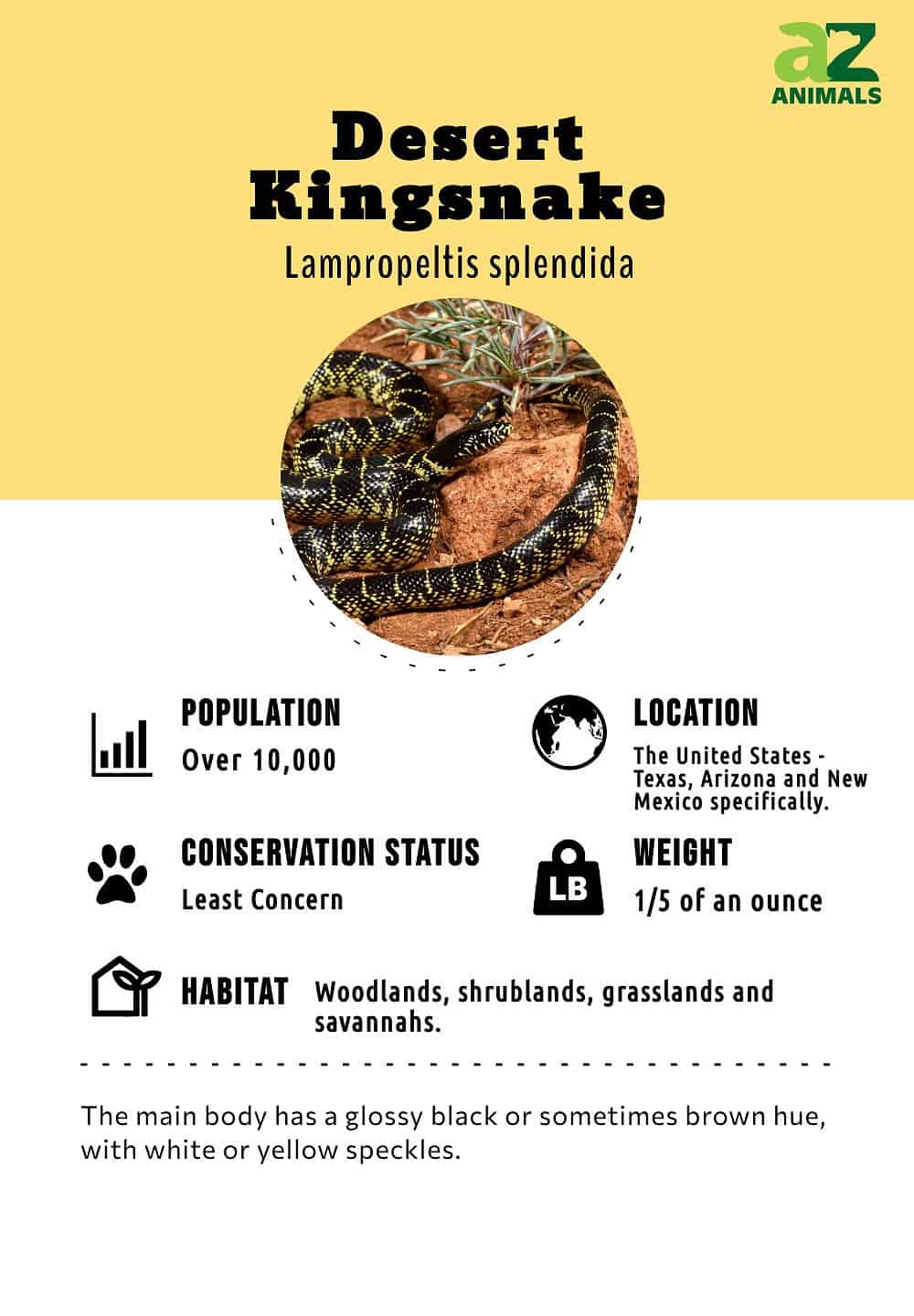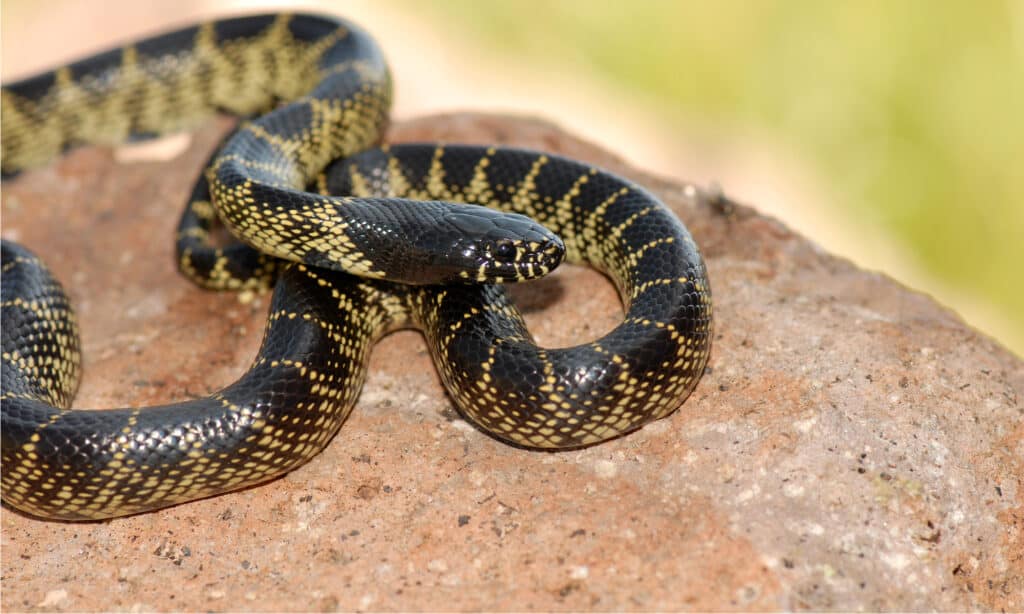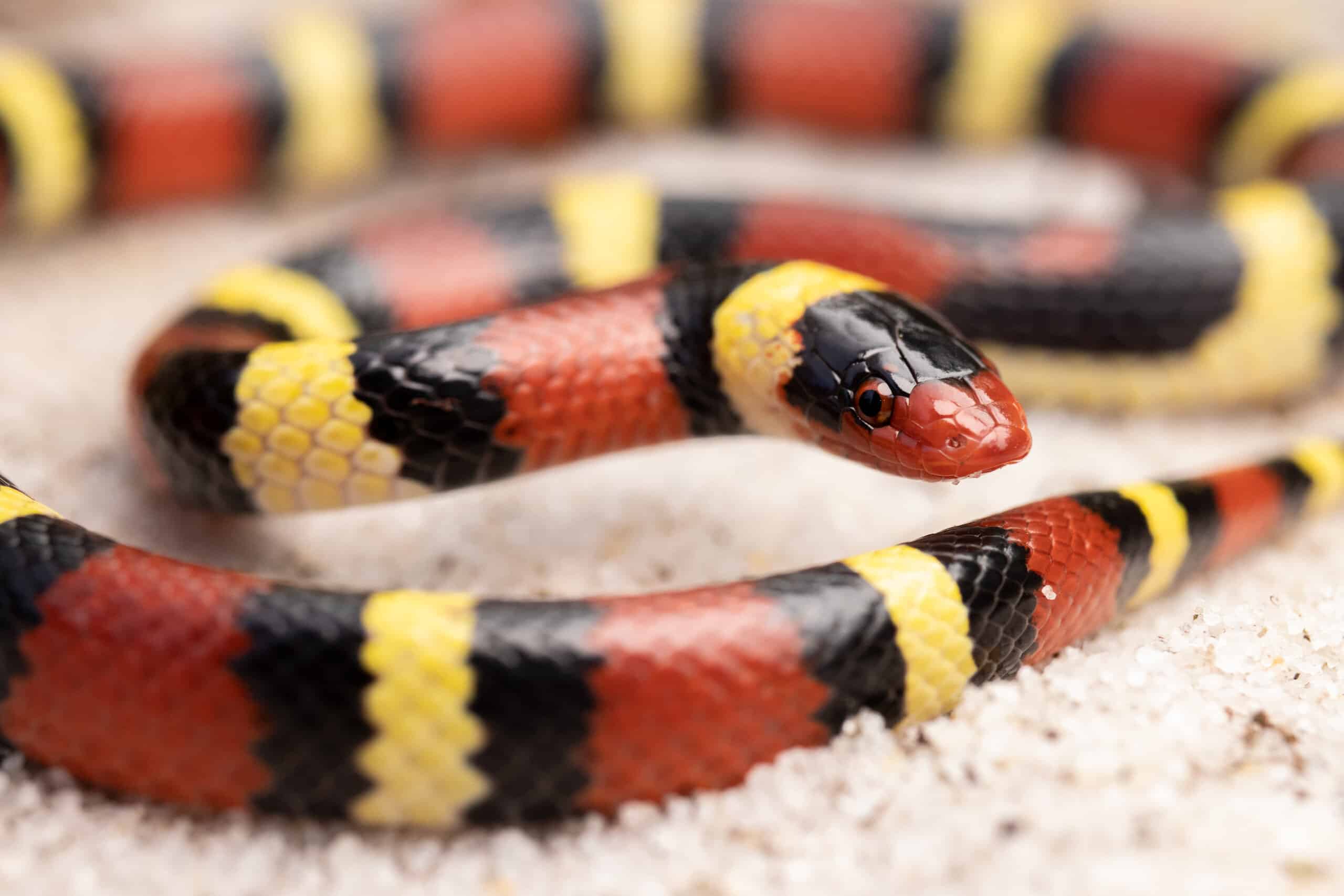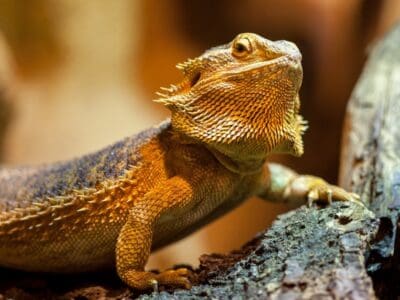Desert Kingsnake
Lampropeltis splendida
The desert kingsnake rolls over and plays dead when it feels threatened.
Advertisement
Desert Kingsnake Scientific Classification
- Kingdom
- Animalia
- Phylum
- Chordata
- Class
- Reptilia
- Order
- Squamata
- Family
- Colubridae
- Genus
- Lampropeltis
- Scientific Name
- Lampropeltis splendida
Read our Complete Guide to Classification of Animals.
Desert Kingsnake Conservation Status
Desert Kingsnake Facts
- Common Name
- Desert Kingsnake
Desert Kingsnake Physical Characteristics
- Color
- Yellow
- Black
- Lifespan
- 12-20 years
- Length
- 3-4 feet
- Venomous
- No
- Aggression
- Low
View all of the Desert Kingsnake images!
The desert kingsnake is only found in the United States.
Featuring a black or brown body with light-colored speckles all over it, the desert kingsnake may look intimidating, but it is one of the friendliest species around with no teeth and no venom. Plus, they won’t attack if they are afraid! Instead, they’ll roll over and play dead, hoping the threat will leave them alone.
5 Amazing Desert Kingsnake Facts
- While these snakes will eat a wide variety of rodents and lizards in their diet, they will also eat rattlesnakes if the opportunity arises.
- The desert kingsnake lays eggs after fertilization between March and June. Clutch sizes range from 5-12 eggs, and the snake will sometimes bury them up to 1 foot underground to keep the shells from drying out.
- They can only be found in the wild in Arizona, New Mexico, and Texas, preferring a temperature of 83-87 degrees Fahrenheit.
- In captivity, they need to be fed at least 1-2 mice weekly to satisfy their appetite.
- Though their scientific name comes from their “splendid” colors, they are also bred as albino snakes.

Where To Find Desert Kingsnakes
These snakes may have seemingly steady numbers, but they aren’t found in very many locations. They only live in Texas, Arizona, and New Mexico in the United States. Though these states are close to the border, there are no reports of it in Mexico. They prefer a rural habitat, seeking out areas near water, despite the fact that these states are notorious for their desert environments.
If you keep the desert kingsnake as a pet, its daytime temperature should be 83-87 degrees Fahrenheit. At night, the temperature should not fall below 68 degrees Fahrenheit.
Scientific Name
The desert kingsnake has the scientific name Lampropeltis splendida. The name is Greek in origin. “Lampropeltis” essentially means “radiant small shields,” while “splendida” is meant to be a description of their splendid colors.
This snake is part of the Reptilia class and the Colubridae family.
Evolution And History

Desert Kingsnake
©Rusty Dodson/Shutterstock.com
The desert kingsnake belongs to the largest family of snakes in the world, the Colubridae, which dates back 33 to 23 million years ago, to the Cenozoic era when the first fossils were found. The most variations of the species were seen during the Miocene era, 25 to 5 million years ago It is believed that these snakes originated in what is now Asia, then migrated to Europe, and eventually made their way to North America.
Types Of Kingsnakes

The Scarlet Kingsnake is one of 26 species of the genus
Lampropeltis© Radiant Reptilia/Shutterstock.com
The desert kingsnake belongs to the genus Lampropeltis which contains 26 species of snakes and 45 recognized subspecies. Some of these 26 snakes are:
- Scarlet Kingsnake
- Speckled Kingsnake
- Common Kingsnake
- California Kingsnake
- Gray-banded Kingsnake
- Mole Kingsnake
- Milk Snake
- California Mountain Kingsnake
- Ecuadorian Milk Snake
- Short-tailed Snake
Population And Conservation Status
Researchers estimate the total population of desert kingsnakes to be over 10,000 in the United States. The conservation status is “Least Concern,” and the population is stable.
Appearance And Description

Desert Kingsnakes have a black or brown body with speckles of white or yellow throughout.
©Rusty Dodson/Shutterstock.com
The colors of these snakes are black and yellow. While the main body has a glossy black or sometimes brown hue, the speckles along it are some shade of white or yellow. The flecks of contracting color match the pale scales along the lower side of the kingsnake, though the abdomen is predominantly black in both full-grown snakes and juveniles. They have 23-25 rows of smooth dorsal scales, and they typically reach lengths of 3-4 feet in size.
Though albino desert kingsnakes exist, they are primarily bred for the pet trade, only reaching 12-14 inches in total size when they are sold.
How to identify a desert kingsnake:
- 3-4 feet long at the full-grown size.
- Up to 25 rows of dorsal scales with smooth texture.
- Black or brown body with speckles of white or yellow throughout.
How Dangerous Are They?
Though these snakes may seem intimidating, they are not dangerous to humans at all. They have a carnivorous diet, but they aren’t venomous. They don’t even have teeth to bite you! If you end up seeing one, they won’t likely attack when provoked even. Instead, they will become motionless and turn onto their backs in an effort to appear dead. When the threat has passed, they resume their daily routine.
Behavior And Humans
The docile and friendly nature of desert kingsnakes makes them excellent pets, and they are easy to find with local breeders in New Mexico, Arizona, and Texas. They aren’t harmful to humans, and they often bond deeply with their keepers when they are handled properly and fed a healthy diet. Some desert kingsnakes even cozy up to their keeper as a way to get warmer.
View all 126 animals that start with DDesert Kingsnake FAQs (Frequently Asked Questions)
Do desert kingsnakes make good pets?
Absolutely. Part of the reason that desert kingsnakes are so popular is because of their friendly and docile nature. They can be handled easily, making the bonding experience even more enjoyable. They don’t lash out if they become scared, and they are one of the most affectionate snakes when it comes to interaction with their keeper. You can choose from multiple colorations, though their size may vary with the breeder. Albino desert kingsnakes can be quite docile as well, as long as you keep up with the needs of their daily care.
Are desert kingsnakes venomous?
No. The desert kingsnake has no venom.
Are desert kingsnakes poisonous?
No. The desert kingsnake is relatively harmless with no venom or teeth.
Are desert kingsnakes nocturnal?
Yes. The most active times of day for the desert kingsnake are late evening and nighttime, allowing the snake to be secretive and concealed within the dark of the night.
How do you take care of a desert kingsnake?
When you keep a desert kingsnake as a pet, you need to offer fresh and clean water at all times within a large water bowl. Most of the time, they’ll need daily refills, though you’ll need to purchase products that remove minerals and other unwanted substances if you use tap water. They also need 1-2 mice weekly, though a medium size rat should also satisfy their appetite. They have no problem eating defrosted rodents, though hatchlings will need much smaller mice. They have a lifespan of up to 20 years while in captivity and will grow up to 5 feet long as a full-grown adult with a large enough tank.
What do desert kingsnakes eat?
The primary diet of the desert kingsnake includes mice and other rodents. It also eats reptile eggs, which it can find underground as it follows the smell. They are able to consume other snakes because they are immune to the venom of vipers and even rattlesnakes.
How do desert kingsnakes hunt?
The desert kingsnake is a constrictor, capturing its prey and suffocating it by compressing their body around them.
Are desert kingsnakes aggressive?
Not at all. Part of the reason that people care for it as a pet is because it is friendly and not aggressive.
Where do desert kingsnakes live?
The only places that desert kingsnakes are endemic to are Texas, New Mexico, and Arizona in the United States. Despite having substantial desert terrain, these snakes like to be near water.
Thank you for reading! Have some feedback for us? Contact the AZ Animals editorial team.
Sources
- Wikipedia / Accessed May 12, 2022
- Reptiles Web / Accessed May 12, 2022
- Reptiles Cove / Accessed May 12, 2022

















